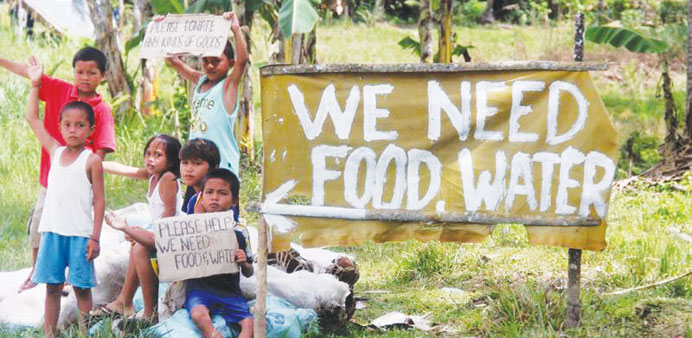Children from Sagbayan town in Bohol plead for food and water with passing motorists yesterday.
Manila Times/Sagbayan, Bohol
Dozens of families in Bohol province now have to contend with water-borne diseases and hunger as many areas continue to grapple with food and water shortage.
Since the quake struck, residents in several towns in Bohol have had no access to clean and potable water because water reservoirs were also destroyed by the 7.2 temblor.
Ways to find food and water is a daily problem for residents of the towns of Carmen and Sagbayan, two of the hardest-hit areas. The world-famous Chocolate Hills are located in Carmen town.
Officials fear that these towns may soon face diarrhoea outbreak because the people have no choice but to drink water from questionable sources.
Children, along with their parents, line the national highway that links Sagbayan and Carmen towns, begging for food and water from passing motorists. Residents have complained that delivery of government aid has been slow.Felisa Lamoste, 42, who is currently staying in a shanty erected at the Sagbayan municipal plaza after her house was totally damaged by the quake on Oct 16, said she and other residents of her town are going hungry.
“It’s hard to survive. We’re experiencing starvation because food rations are delayed and we are also in dire need of drinking water,” she told Manila Times.
She admitted that it will take time for them to recover from the impact of the earthquake that killed almost 200 people.
Carmen Mayor Ricardo Francisco Toribio admitted that Boholanons will not be able to recover from the calamity without the assistance of the national government and other groups. Toribio said the quake totally damaged at least 2,000 houses and partially damaged 5,000 others in his town.
President Benigno Aquino visited Bohol for the second time yesterday to check on the delivery of aid to the quake victims.
The president proceeded to the town of Loon where he visited the Loon South Central School evacuation centre, the Our Lady of Light Parish and the town’s public market.
The visit came following complaints that government aid had not reached residents in some towns because of the slow delivery of supplies.
At the House of Representatives, Muntinlupa Rep. Rodolfo Biazon proposed ways to address the funding requirements of calamity-hit areas amid calls by Bohol provincial government for a congressional intervention to fast-track the province’s full rehabilitation that would cost several billions of pesos.
Biazon presented his proposal during a briefing of the National Disaster Risk Reduction and Management Council (NDRRMC) for the Cabinet oversight committee on disaster and relief, which he chairs, in Camp Aguinaldo, Quezon City.
Biazon said Congress can solve the funding problems by realigning the P24.5bn Priority Development Assistance Fund (PDAF) tucked in the 2014 national budget, legal reclassification of certain funds and by providing a supplemental budget through a joint resolution of the House of Representatives and Senate.
He stressed that his proposal would cover not only Bohol but also conflict-hit areas in Zamboanga City as well as provinces affected by typhoon Santi in Central Luzon and areas devastated by typhoon Sendong.
“My proposal is to realign the PDAF of P24.5bn in 2014 to this, not just for Bohol, but also to include Zamboanga along with Central Luzon,” Biazon said.
“Now if that (PDAF) is not even sufficient, the next probable legislative response would be reclassification of certain funds and the third possible way would be to probably have it done by a joint resolution of Congress of both houses proposing for a supplemental budget,” he added
But before it can be done, Biazon said Congress needs to know first how much is needed so that it can determine whether the available funds are sufficient or there should be additional funds to be generated by Congress in the form of supplemental budget.“If we talked of congressional response, the NDRRMC should first come out with an evaluation specifying the amount needed by Zamboanga, Bohol, Central Luzon, and how much is needed from damages from previous disasters like (typhoon) Sendong,” the lawmaker said.
Biazon said he was disappointed with the slow distribution of relief goods to isolated areas in Bohol despite claims by authorities that seven helicopters had been dispatched to the calamity areas to deliver supplies.“Why is it that until now the non-delivery of supplies to certain places remains an issue?” he asked.
Earlier, Bohol provincial government spokesman Tootsie Escobia said that only P40mn of the province’s P70mn calamity fund is left.
He stressed that Bohol needs intervention from Congress and other foreign assistance to fast-track full rehabilitation.
Escobia said the Bohol provincial government and the Department of Social Welfare and Development have so far jointly distributed 130,475 family food packs to 34 municipalities with a daily dispatch of 20,000 packs.
But the main challenge, she added, is the delivery of goods to areas where the roads have been rendered impassable by the magnitude 7.2 earthquake.
Escobia said Bohol has enough rice supply for the next 30 days.

